Detailed Report on Management Accounting for Qbic Hotel
VerifiedAdded on 2023/01/20
|20
|4880
|35
Report
AI Summary
This report provides a comprehensive analysis of management accounting practices, focusing on their application within Qbic Hotel. It begins with an introduction to management accounting, its essential requirements, and various systems like job costing, cost accounting, inventory accounting, and price optimization. The report then assesses the use of managerial reporting, including budget reports, job cost reports, inventory reports, and accounts receivable aging reports, in supporting effective decision-making. A key section delves into the calculation of income statements under both marginal costing and absorption costing methods, comparing their impact on net profit. The report also examines the advantages and disadvantages of planning tools, particularly budgetary control, and explores how different organizations adapt management accounting to address financial challenges. Finally, it evaluates the role of planning tools in resolving financial problems and driving organizational success, highlighting the importance of management accounting in achieving sustainable outcomes. This assignment is a valuable resource for students studying business development and management accounting.
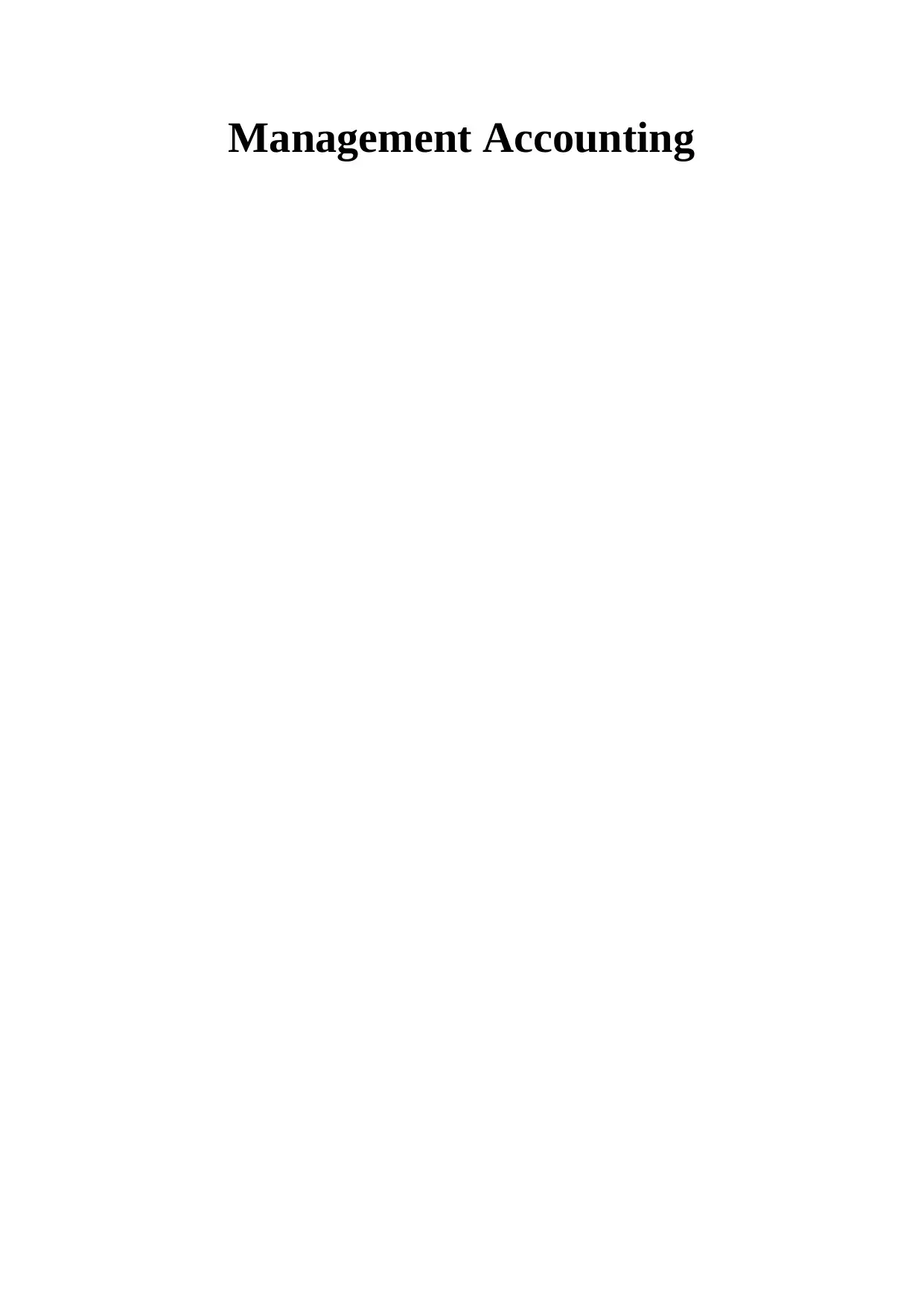
Management Accounting
Paraphrase This Document
Need a fresh take? Get an instant paraphrase of this document with our AI Paraphraser
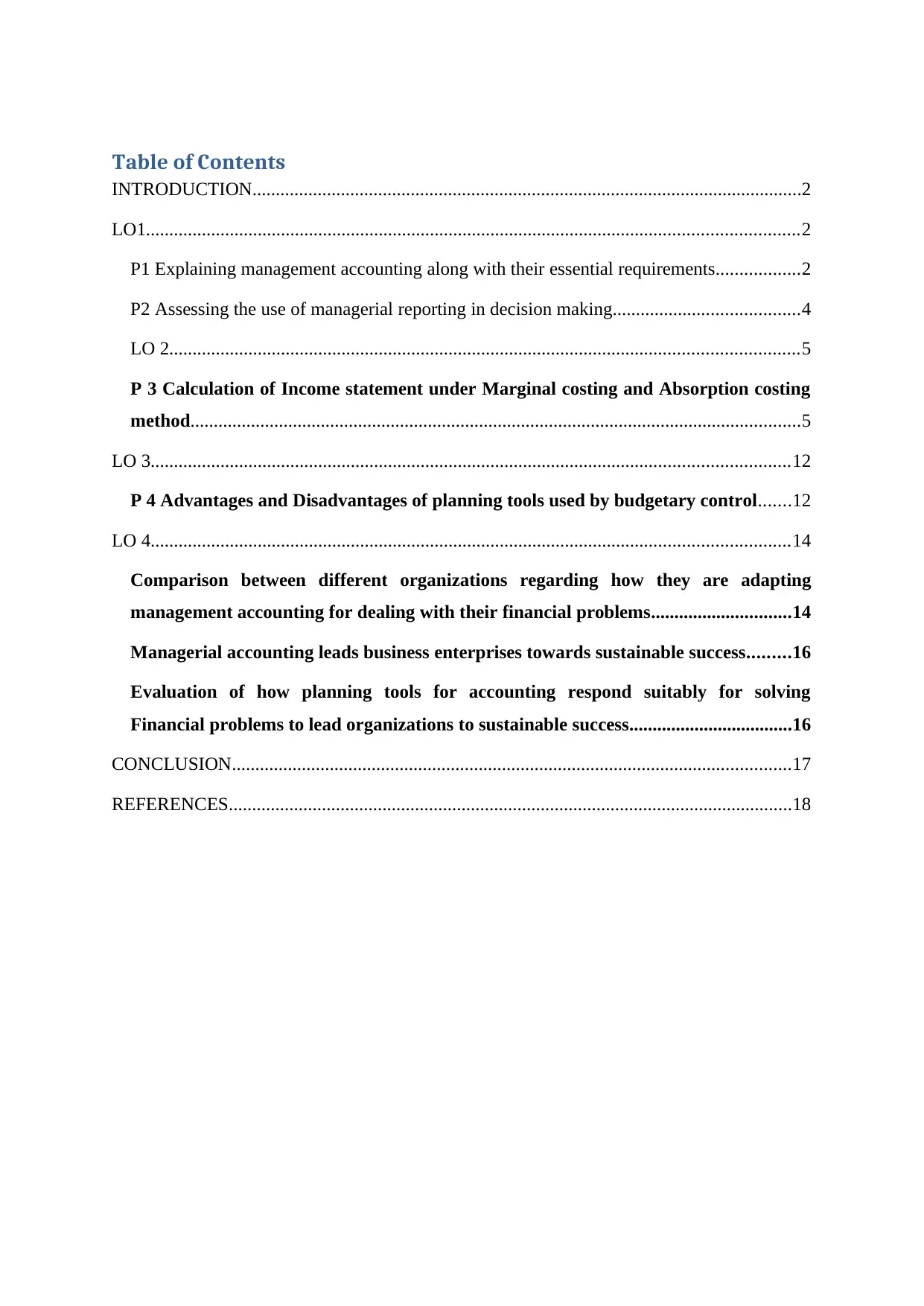
Table of Contents
INTRODUCTION......................................................................................................................2
LO1............................................................................................................................................2
P1 Explaining management accounting along with their essential requirements..................2
P2 Assessing the use of managerial reporting in decision making........................................4
LO 2.......................................................................................................................................5
P 3 Calculation of Income statement under Marginal costing and Absorption costing
method...................................................................................................................................5
LO 3.........................................................................................................................................12
P 4 Advantages and Disadvantages of planning tools used by budgetary control.......12
LO 4.........................................................................................................................................14
Comparison between different organizations regarding how they are adapting
management accounting for dealing with their financial problems..............................14
Managerial accounting leads business enterprises towards sustainable success.........16
Evaluation of how planning tools for accounting respond suitably for solving
Financial problems to lead organizations to sustainable success...................................16
CONCLUSION........................................................................................................................17
REFERENCES.........................................................................................................................18
INTRODUCTION......................................................................................................................2
LO1............................................................................................................................................2
P1 Explaining management accounting along with their essential requirements..................2
P2 Assessing the use of managerial reporting in decision making........................................4
LO 2.......................................................................................................................................5
P 3 Calculation of Income statement under Marginal costing and Absorption costing
method...................................................................................................................................5
LO 3.........................................................................................................................................12
P 4 Advantages and Disadvantages of planning tools used by budgetary control.......12
LO 4.........................................................................................................................................14
Comparison between different organizations regarding how they are adapting
management accounting for dealing with their financial problems..............................14
Managerial accounting leads business enterprises towards sustainable success.........16
Evaluation of how planning tools for accounting respond suitably for solving
Financial problems to lead organizations to sustainable success...................................16
CONCLUSION........................................................................................................................17
REFERENCES.........................................................................................................................18
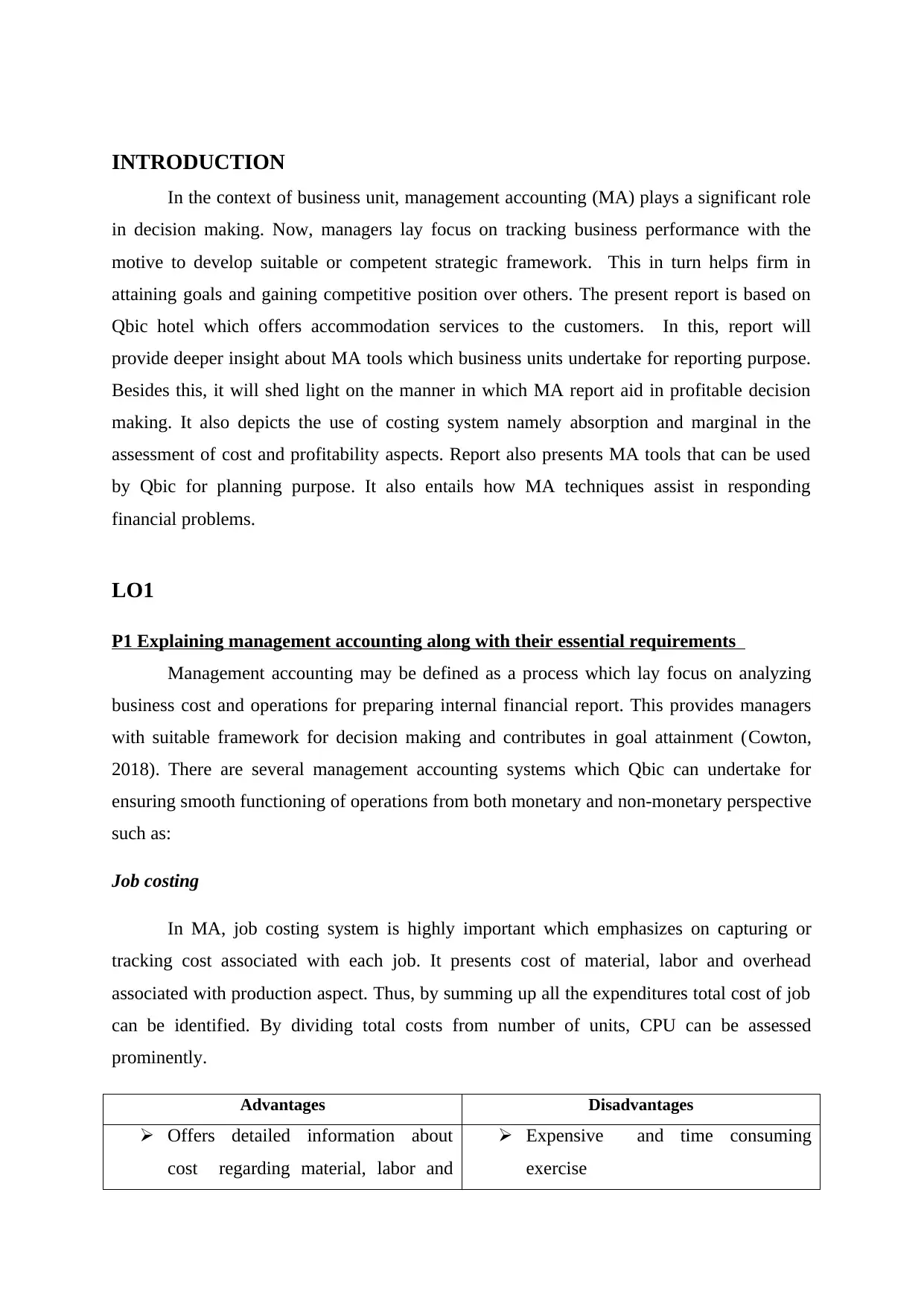
INTRODUCTION
In the context of business unit, management accounting (MA) plays a significant role
in decision making. Now, managers lay focus on tracking business performance with the
motive to develop suitable or competent strategic framework. This in turn helps firm in
attaining goals and gaining competitive position over others. The present report is based on
Qbic hotel which offers accommodation services to the customers. In this, report will
provide deeper insight about MA tools which business units undertake for reporting purpose.
Besides this, it will shed light on the manner in which MA report aid in profitable decision
making. It also depicts the use of costing system namely absorption and marginal in the
assessment of cost and profitability aspects. Report also presents MA tools that can be used
by Qbic for planning purpose. It also entails how MA techniques assist in responding
financial problems.
LO1
P1 Explaining management accounting along with their essential requirements
Management accounting may be defined as a process which lay focus on analyzing
business cost and operations for preparing internal financial report. This provides managers
with suitable framework for decision making and contributes in goal attainment (Cowton,
2018). There are several management accounting systems which Qbic can undertake for
ensuring smooth functioning of operations from both monetary and non-monetary perspective
such as:
Job costing
In MA, job costing system is highly important which emphasizes on capturing or
tracking cost associated with each job. It presents cost of material, labor and overhead
associated with production aspect. Thus, by summing up all the expenditures total cost of job
can be identified. By dividing total costs from number of units, CPU can be assessed
prominently.
Advantages Disadvantages
Offers detailed information about
cost regarding material, labor and
Expensive and time consuming
exercise
In the context of business unit, management accounting (MA) plays a significant role
in decision making. Now, managers lay focus on tracking business performance with the
motive to develop suitable or competent strategic framework. This in turn helps firm in
attaining goals and gaining competitive position over others. The present report is based on
Qbic hotel which offers accommodation services to the customers. In this, report will
provide deeper insight about MA tools which business units undertake for reporting purpose.
Besides this, it will shed light on the manner in which MA report aid in profitable decision
making. It also depicts the use of costing system namely absorption and marginal in the
assessment of cost and profitability aspects. Report also presents MA tools that can be used
by Qbic for planning purpose. It also entails how MA techniques assist in responding
financial problems.
LO1
P1 Explaining management accounting along with their essential requirements
Management accounting may be defined as a process which lay focus on analyzing
business cost and operations for preparing internal financial report. This provides managers
with suitable framework for decision making and contributes in goal attainment (Cowton,
2018). There are several management accounting systems which Qbic can undertake for
ensuring smooth functioning of operations from both monetary and non-monetary perspective
such as:
Job costing
In MA, job costing system is highly important which emphasizes on capturing or
tracking cost associated with each job. It presents cost of material, labor and overhead
associated with production aspect. Thus, by summing up all the expenditures total cost of job
can be identified. By dividing total costs from number of units, CPU can be assessed
prominently.
Advantages Disadvantages
Offers detailed information about
cost regarding material, labor and
Expensive and time consuming
exercise
⊘ This is a preview!⊘
Do you want full access?
Subscribe today to unlock all pages.

Trusted by 1+ million students worldwide
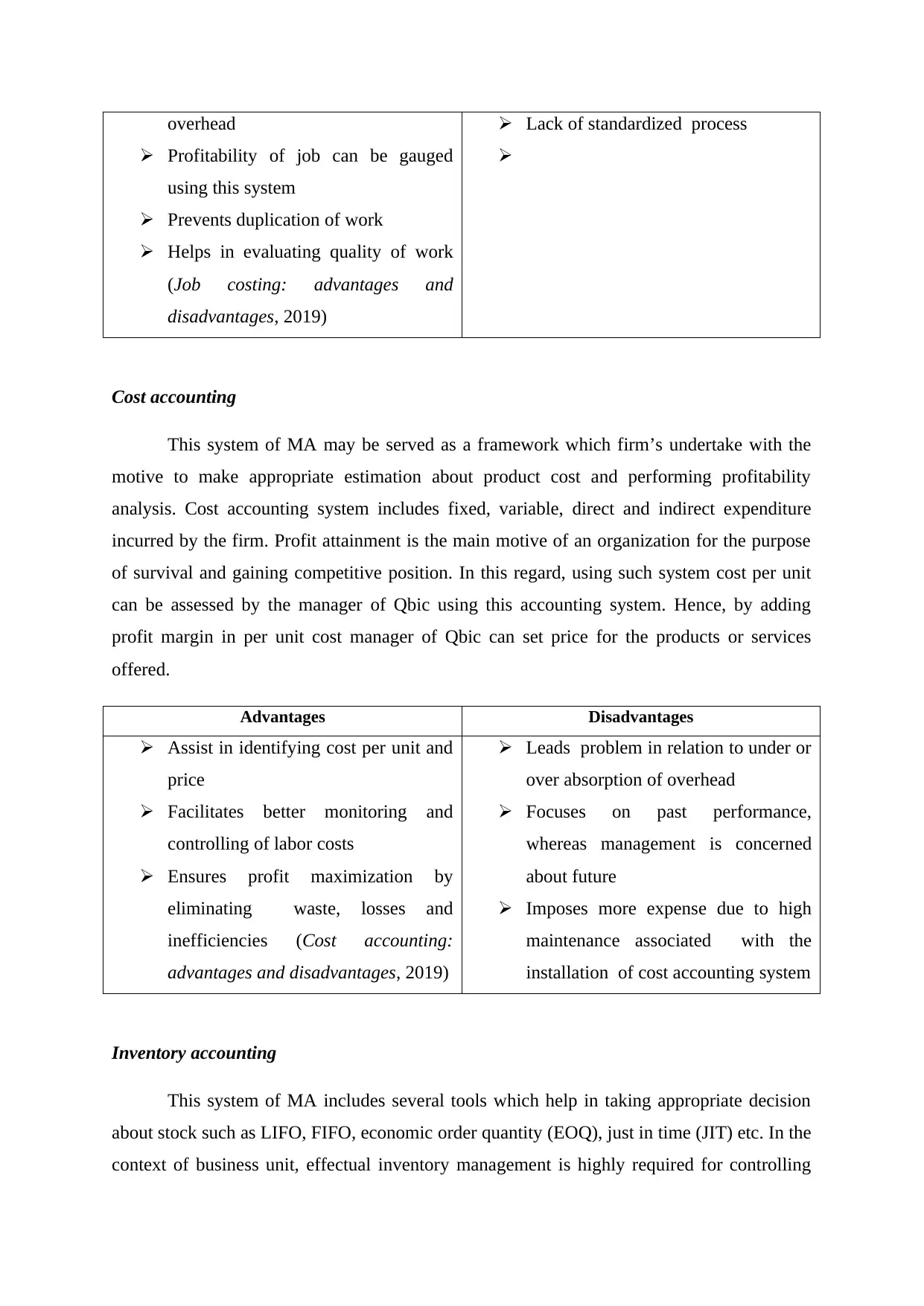
overhead
Profitability of job can be gauged
using this system
Prevents duplication of work
Helps in evaluating quality of work
(Job costing: advantages and
disadvantages, 2019)
Lack of standardized process
Cost accounting
This system of MA may be served as a framework which firm’s undertake with the
motive to make appropriate estimation about product cost and performing profitability
analysis. Cost accounting system includes fixed, variable, direct and indirect expenditure
incurred by the firm. Profit attainment is the main motive of an organization for the purpose
of survival and gaining competitive position. In this regard, using such system cost per unit
can be assessed by the manager of Qbic using this accounting system. Hence, by adding
profit margin in per unit cost manager of Qbic can set price for the products or services
offered.
Advantages Disadvantages
Assist in identifying cost per unit and
price
Facilitates better monitoring and
controlling of labor costs
Ensures profit maximization by
eliminating waste, losses and
inefficiencies (Cost accounting:
advantages and disadvantages, 2019)
Leads problem in relation to under or
over absorption of overhead
Focuses on past performance,
whereas management is concerned
about future
Imposes more expense due to high
maintenance associated with the
installation of cost accounting system
Inventory accounting
This system of MA includes several tools which help in taking appropriate decision
about stock such as LIFO, FIFO, economic order quantity (EOQ), just in time (JIT) etc. In the
context of business unit, effectual inventory management is highly required for controlling
Profitability of job can be gauged
using this system
Prevents duplication of work
Helps in evaluating quality of work
(Job costing: advantages and
disadvantages, 2019)
Lack of standardized process
Cost accounting
This system of MA may be served as a framework which firm’s undertake with the
motive to make appropriate estimation about product cost and performing profitability
analysis. Cost accounting system includes fixed, variable, direct and indirect expenditure
incurred by the firm. Profit attainment is the main motive of an organization for the purpose
of survival and gaining competitive position. In this regard, using such system cost per unit
can be assessed by the manager of Qbic using this accounting system. Hence, by adding
profit margin in per unit cost manager of Qbic can set price for the products or services
offered.
Advantages Disadvantages
Assist in identifying cost per unit and
price
Facilitates better monitoring and
controlling of labor costs
Ensures profit maximization by
eliminating waste, losses and
inefficiencies (Cost accounting:
advantages and disadvantages, 2019)
Leads problem in relation to under or
over absorption of overhead
Focuses on past performance,
whereas management is concerned
about future
Imposes more expense due to high
maintenance associated with the
installation of cost accounting system
Inventory accounting
This system of MA includes several tools which help in taking appropriate decision
about stock such as LIFO, FIFO, economic order quantity (EOQ), just in time (JIT) etc. In the
context of business unit, effectual inventory management is highly required for controlling
Paraphrase This Document
Need a fresh take? Get an instant paraphrase of this document with our AI Paraphraser
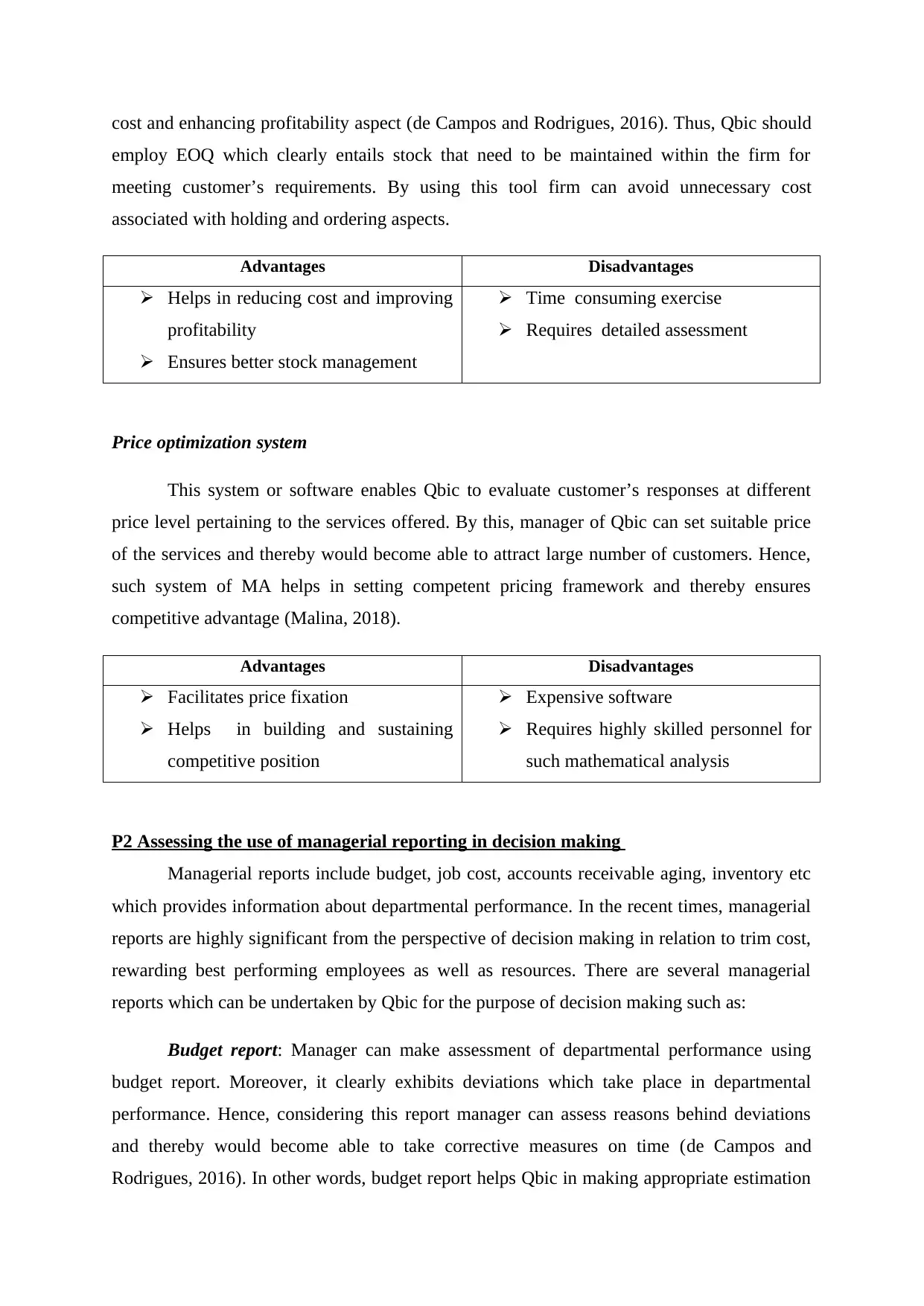
cost and enhancing profitability aspect (de Campos and Rodrigues, 2016). Thus, Qbic should
employ EOQ which clearly entails stock that need to be maintained within the firm for
meeting customer’s requirements. By using this tool firm can avoid unnecessary cost
associated with holding and ordering aspects.
Advantages Disadvantages
Helps in reducing cost and improving
profitability
Ensures better stock management
Time consuming exercise
Requires detailed assessment
Price optimization system
This system or software enables Qbic to evaluate customer’s responses at different
price level pertaining to the services offered. By this, manager of Qbic can set suitable price
of the services and thereby would become able to attract large number of customers. Hence,
such system of MA helps in setting competent pricing framework and thereby ensures
competitive advantage (Malina, 2018).
Advantages Disadvantages
Facilitates price fixation
Helps in building and sustaining
competitive position
Expensive software
Requires highly skilled personnel for
such mathematical analysis
P2 Assessing the use of managerial reporting in decision making
Managerial reports include budget, job cost, accounts receivable aging, inventory etc
which provides information about departmental performance. In the recent times, managerial
reports are highly significant from the perspective of decision making in relation to trim cost,
rewarding best performing employees as well as resources. There are several managerial
reports which can be undertaken by Qbic for the purpose of decision making such as:
Budget report: Manager can make assessment of departmental performance using
budget report. Moreover, it clearly exhibits deviations which take place in departmental
performance. Hence, considering this report manager can assess reasons behind deviations
and thereby would become able to take corrective measures on time (de Campos and
Rodrigues, 2016). In other words, budget report helps Qbic in making appropriate estimation
employ EOQ which clearly entails stock that need to be maintained within the firm for
meeting customer’s requirements. By using this tool firm can avoid unnecessary cost
associated with holding and ordering aspects.
Advantages Disadvantages
Helps in reducing cost and improving
profitability
Ensures better stock management
Time consuming exercise
Requires detailed assessment
Price optimization system
This system or software enables Qbic to evaluate customer’s responses at different
price level pertaining to the services offered. By this, manager of Qbic can set suitable price
of the services and thereby would become able to attract large number of customers. Hence,
such system of MA helps in setting competent pricing framework and thereby ensures
competitive advantage (Malina, 2018).
Advantages Disadvantages
Facilitates price fixation
Helps in building and sustaining
competitive position
Expensive software
Requires highly skilled personnel for
such mathematical analysis
P2 Assessing the use of managerial reporting in decision making
Managerial reports include budget, job cost, accounts receivable aging, inventory etc
which provides information about departmental performance. In the recent times, managerial
reports are highly significant from the perspective of decision making in relation to trim cost,
rewarding best performing employees as well as resources. There are several managerial
reports which can be undertaken by Qbic for the purpose of decision making such as:
Budget report: Manager can make assessment of departmental performance using
budget report. Moreover, it clearly exhibits deviations which take place in departmental
performance. Hence, considering this report manager can assess reasons behind deviations
and thereby would become able to take corrective measures on time (de Campos and
Rodrigues, 2016). In other words, budget report helps Qbic in making appropriate estimation
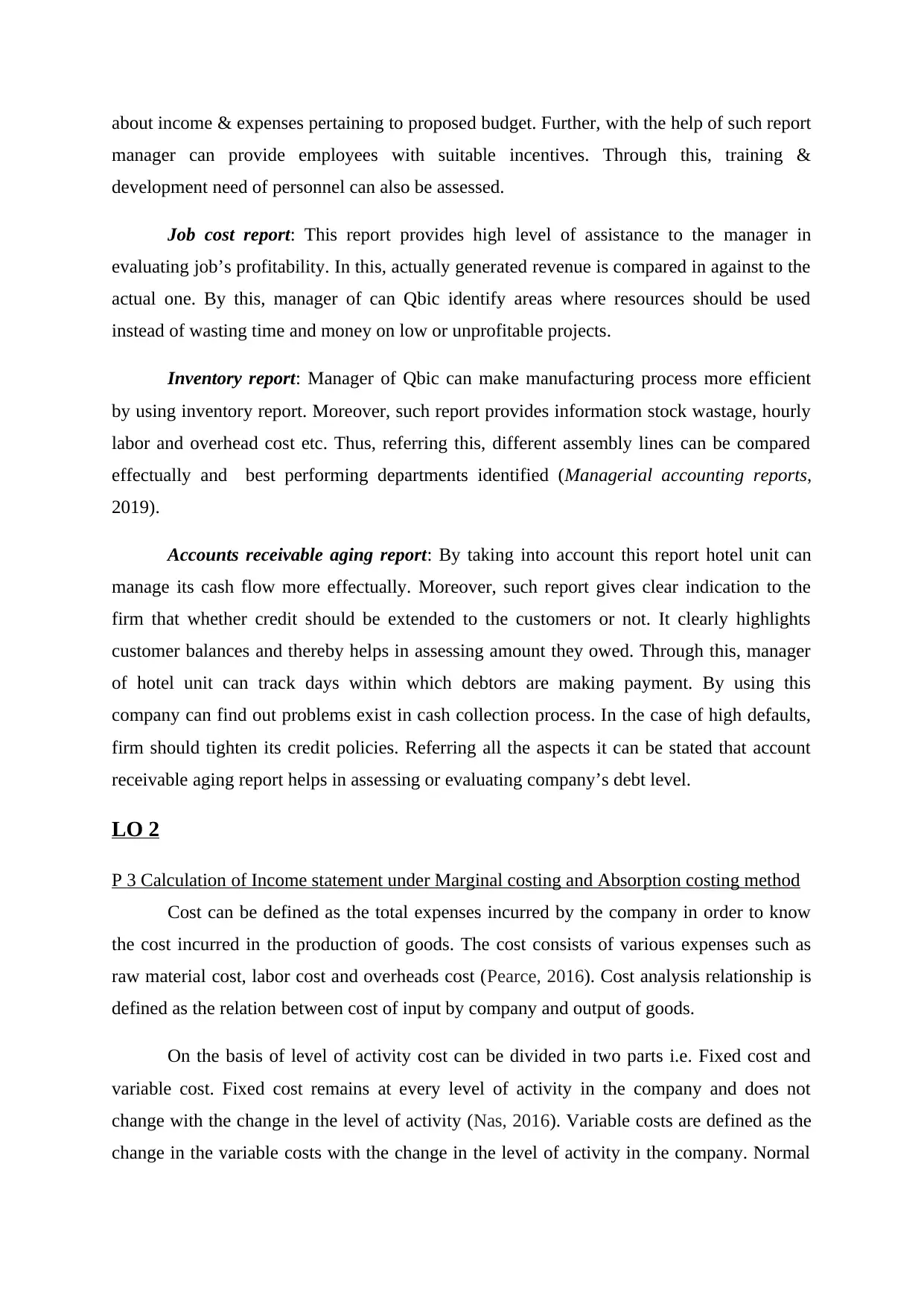
about income & expenses pertaining to proposed budget. Further, with the help of such report
manager can provide employees with suitable incentives. Through this, training &
development need of personnel can also be assessed.
Job cost report: This report provides high level of assistance to the manager in
evaluating job’s profitability. In this, actually generated revenue is compared in against to the
actual one. By this, manager of can Qbic identify areas where resources should be used
instead of wasting time and money on low or unprofitable projects.
Inventory report: Manager of Qbic can make manufacturing process more efficient
by using inventory report. Moreover, such report provides information stock wastage, hourly
labor and overhead cost etc. Thus, referring this, different assembly lines can be compared
effectually and best performing departments identified (Managerial accounting reports,
2019).
Accounts receivable aging report: By taking into account this report hotel unit can
manage its cash flow more effectually. Moreover, such report gives clear indication to the
firm that whether credit should be extended to the customers or not. It clearly highlights
customer balances and thereby helps in assessing amount they owed. Through this, manager
of hotel unit can track days within which debtors are making payment. By using this
company can find out problems exist in cash collection process. In the case of high defaults,
firm should tighten its credit policies. Referring all the aspects it can be stated that account
receivable aging report helps in assessing or evaluating company’s debt level.
LO 2
P 3 Calculation of Income statement under Marginal costing and Absorption costing method
Cost can be defined as the total expenses incurred by the company in order to know
the cost incurred in the production of goods. The cost consists of various expenses such as
raw material cost, labor cost and overheads cost (Pearce, 2016). Cost analysis relationship is
defined as the relation between cost of input by company and output of goods.
On the basis of level of activity cost can be divided in two parts i.e. Fixed cost and
variable cost. Fixed cost remains at every level of activity in the company and does not
change with the change in the level of activity (Nas, 2016). Variable costs are defined as the
change in the variable costs with the change in the level of activity in the company. Normal
manager can provide employees with suitable incentives. Through this, training &
development need of personnel can also be assessed.
Job cost report: This report provides high level of assistance to the manager in
evaluating job’s profitability. In this, actually generated revenue is compared in against to the
actual one. By this, manager of can Qbic identify areas where resources should be used
instead of wasting time and money on low or unprofitable projects.
Inventory report: Manager of Qbic can make manufacturing process more efficient
by using inventory report. Moreover, such report provides information stock wastage, hourly
labor and overhead cost etc. Thus, referring this, different assembly lines can be compared
effectually and best performing departments identified (Managerial accounting reports,
2019).
Accounts receivable aging report: By taking into account this report hotel unit can
manage its cash flow more effectually. Moreover, such report gives clear indication to the
firm that whether credit should be extended to the customers or not. It clearly highlights
customer balances and thereby helps in assessing amount they owed. Through this, manager
of hotel unit can track days within which debtors are making payment. By using this
company can find out problems exist in cash collection process. In the case of high defaults,
firm should tighten its credit policies. Referring all the aspects it can be stated that account
receivable aging report helps in assessing or evaluating company’s debt level.
LO 2
P 3 Calculation of Income statement under Marginal costing and Absorption costing method
Cost can be defined as the total expenses incurred by the company in order to know
the cost incurred in the production of goods. The cost consists of various expenses such as
raw material cost, labor cost and overheads cost (Pearce, 2016). Cost analysis relationship is
defined as the relation between cost of input by company and output of goods.
On the basis of level of activity cost can be divided in two parts i.e. Fixed cost and
variable cost. Fixed cost remains at every level of activity in the company and does not
change with the change in the level of activity (Nas, 2016). Variable costs are defined as the
change in the variable costs with the change in the level of activity in the company. Normal
⊘ This is a preview!⊘
Do you want full access?
Subscribe today to unlock all pages.

Trusted by 1+ million students worldwide
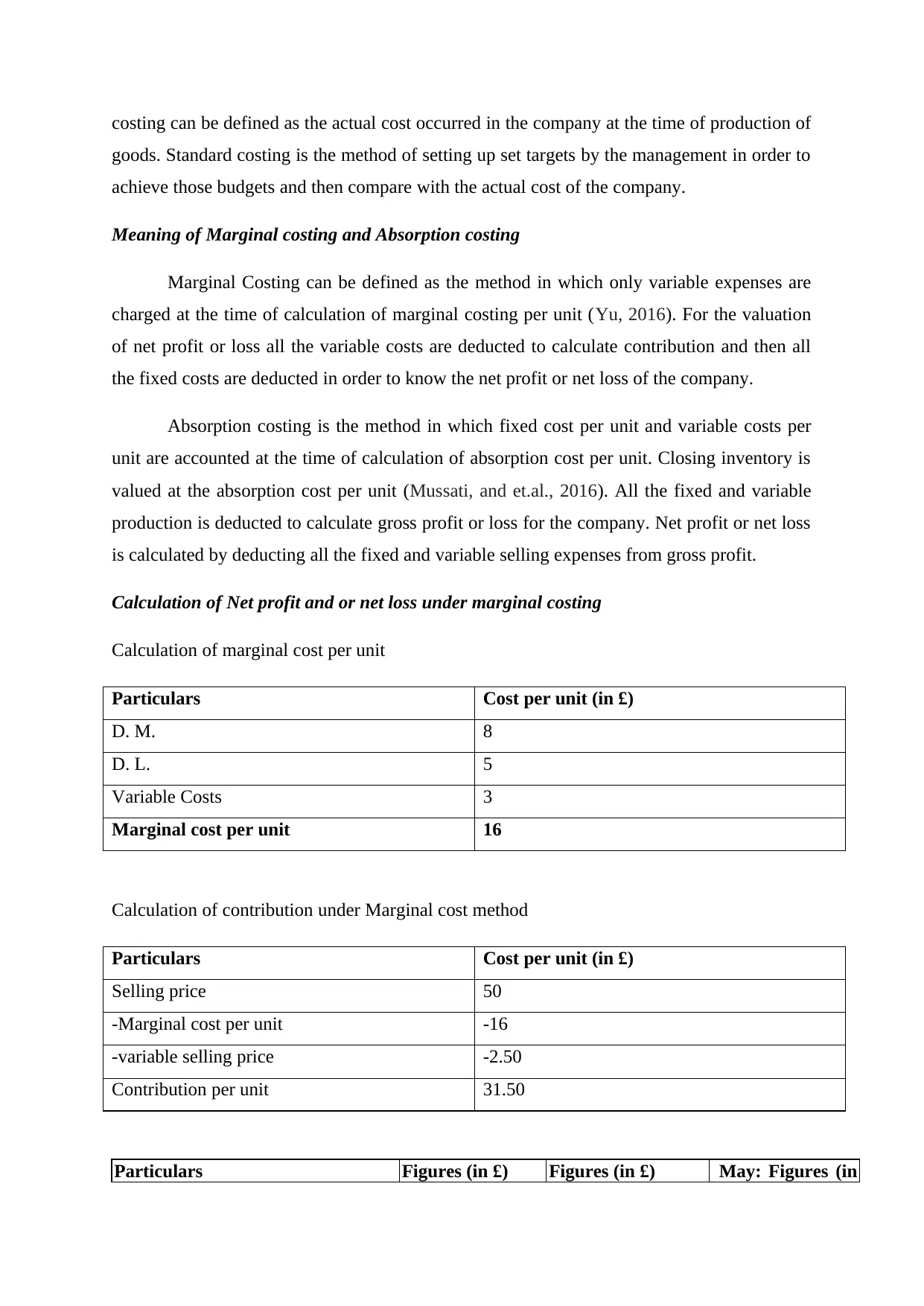
costing can be defined as the actual cost occurred in the company at the time of production of
goods. Standard costing is the method of setting up set targets by the management in order to
achieve those budgets and then compare with the actual cost of the company.
Meaning of Marginal costing and Absorption costing
Marginal Costing can be defined as the method in which only variable expenses are
charged at the time of calculation of marginal costing per unit (Yu, 2016). For the valuation
of net profit or loss all the variable costs are deducted to calculate contribution and then all
the fixed costs are deducted in order to know the net profit or net loss of the company.
Absorption costing is the method in which fixed cost per unit and variable costs per
unit are accounted at the time of calculation of absorption cost per unit. Closing inventory is
valued at the absorption cost per unit (Mussati, and et.al., 2016). All the fixed and variable
production is deducted to calculate gross profit or loss for the company. Net profit or net loss
is calculated by deducting all the fixed and variable selling expenses from gross profit.
Calculation of Net profit and or net loss under marginal costing
Calculation of marginal cost per unit
Particulars Cost per unit (in £)
D. M. 8
D. L. 5
Variable Costs 3
Marginal cost per unit 16
Calculation of contribution under Marginal cost method
Particulars Cost per unit (in £)
Selling price 50
-Marginal cost per unit -16
-variable selling price -2.50
Contribution per unit 31.50
Particulars Figures (in £) Figures (in £) May: Figures (in
goods. Standard costing is the method of setting up set targets by the management in order to
achieve those budgets and then compare with the actual cost of the company.
Meaning of Marginal costing and Absorption costing
Marginal Costing can be defined as the method in which only variable expenses are
charged at the time of calculation of marginal costing per unit (Yu, 2016). For the valuation
of net profit or loss all the variable costs are deducted to calculate contribution and then all
the fixed costs are deducted in order to know the net profit or net loss of the company.
Absorption costing is the method in which fixed cost per unit and variable costs per
unit are accounted at the time of calculation of absorption cost per unit. Closing inventory is
valued at the absorption cost per unit (Mussati, and et.al., 2016). All the fixed and variable
production is deducted to calculate gross profit or loss for the company. Net profit or net loss
is calculated by deducting all the fixed and variable selling expenses from gross profit.
Calculation of Net profit and or net loss under marginal costing
Calculation of marginal cost per unit
Particulars Cost per unit (in £)
D. M. 8
D. L. 5
Variable Costs 3
Marginal cost per unit 16
Calculation of contribution under Marginal cost method
Particulars Cost per unit (in £)
Selling price 50
-Marginal cost per unit -16
-variable selling price -2.50
Contribution per unit 31.50
Particulars Figures (in £) Figures (in £) May: Figures (in
Paraphrase This Document
Need a fresh take? Get an instant paraphrase of this document with our AI Paraphraser
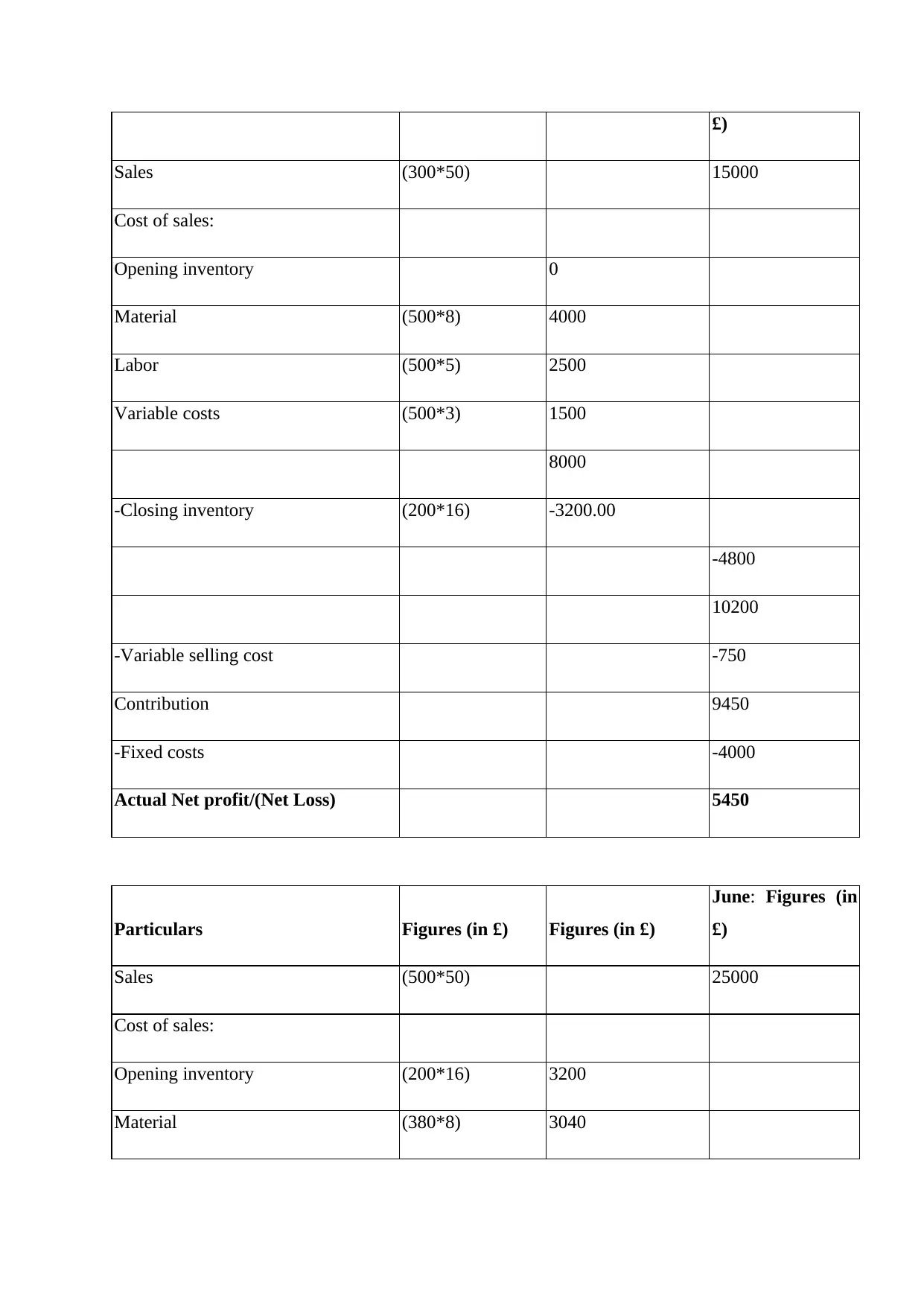
£)
Sales (300*50) 15000
Cost of sales:
Opening inventory 0
Material (500*8) 4000
Labor (500*5) 2500
Variable costs (500*3) 1500
8000
-Closing inventory (200*16) -3200.00
-4800
10200
-Variable selling cost -750
Contribution 9450
-Fixed costs -4000
Actual Net profit/(Net Loss) 5450
Particulars Figures (in £) Figures (in £)
June: Figures (in
£)
Sales (500*50) 25000
Cost of sales:
Opening inventory (200*16) 3200
Material (380*8) 3040
Sales (300*50) 15000
Cost of sales:
Opening inventory 0
Material (500*8) 4000
Labor (500*5) 2500
Variable costs (500*3) 1500
8000
-Closing inventory (200*16) -3200.00
-4800
10200
-Variable selling cost -750
Contribution 9450
-Fixed costs -4000
Actual Net profit/(Net Loss) 5450
Particulars Figures (in £) Figures (in £)
June: Figures (in
£)
Sales (500*50) 25000
Cost of sales:
Opening inventory (200*16) 3200
Material (380*8) 3040
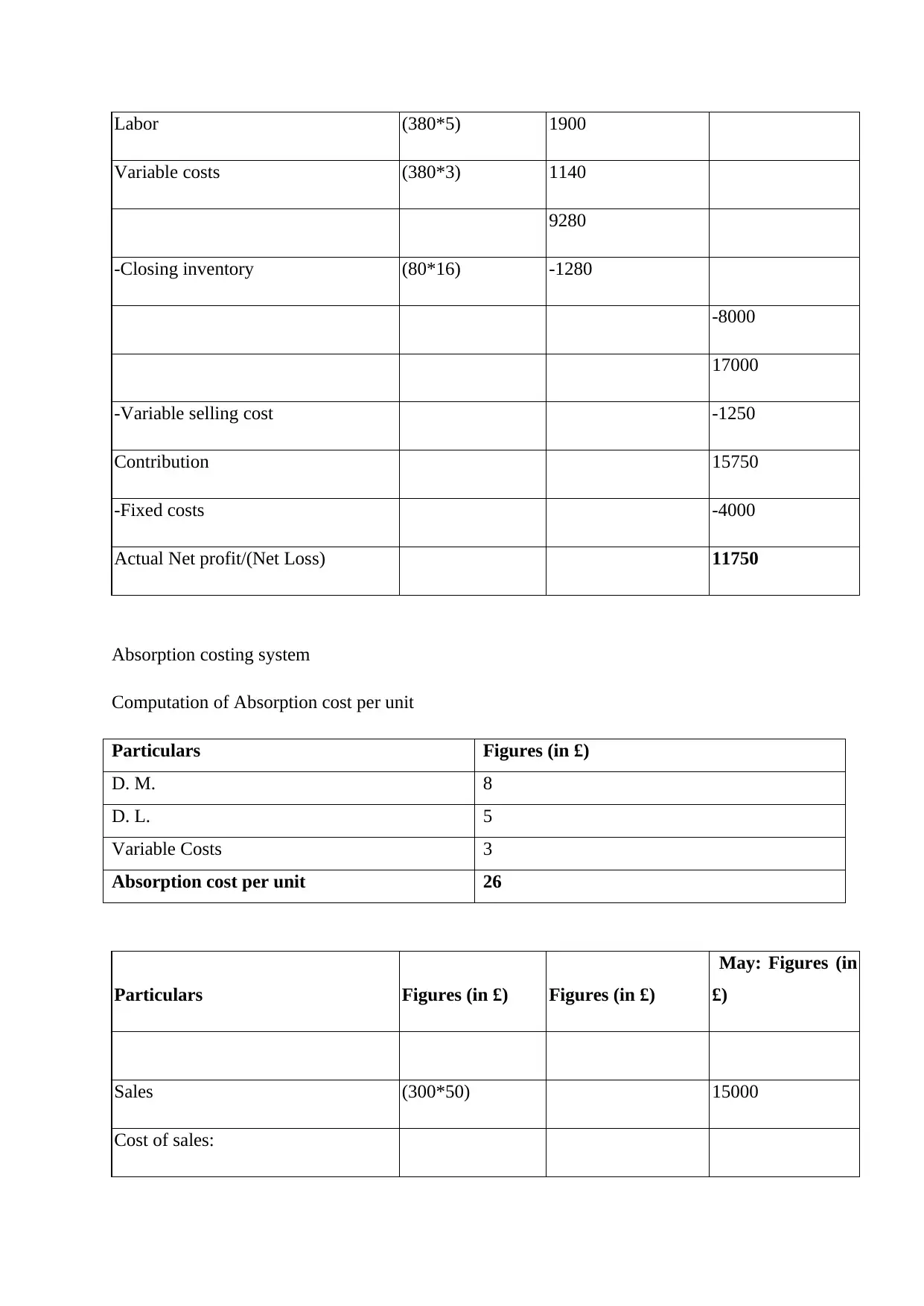
Labor (380*5) 1900
Variable costs (380*3) 1140
9280
-Closing inventory (80*16) -1280
-8000
17000
-Variable selling cost -1250
Contribution 15750
-Fixed costs -4000
Actual Net profit/(Net Loss) 11750
Absorption costing system
Computation of Absorption cost per unit
Particulars Figures (in £)
D. M. 8
D. L. 5
Variable Costs 3
Absorption cost per unit 26
Particulars Figures (in £) Figures (in £)
May: Figures (in
£)
Sales (300*50) 15000
Cost of sales:
Variable costs (380*3) 1140
9280
-Closing inventory (80*16) -1280
-8000
17000
-Variable selling cost -1250
Contribution 15750
-Fixed costs -4000
Actual Net profit/(Net Loss) 11750
Absorption costing system
Computation of Absorption cost per unit
Particulars Figures (in £)
D. M. 8
D. L. 5
Variable Costs 3
Absorption cost per unit 26
Particulars Figures (in £) Figures (in £)
May: Figures (in
£)
Sales (300*50) 15000
Cost of sales:
⊘ This is a preview!⊘
Do you want full access?
Subscribe today to unlock all pages.

Trusted by 1+ million students worldwide

Opening inventory 0
Material (500*8) 4000
Labor (500*5) 2500
Fixed costs 4000
Variable costs (500*3) 1500
12000
-Closing inventory (200*26) -5200
-6800
Gross Profit/Loss 8200
-Variable selling cost -750
Actual Net profit/(Net Loss) 7450
Particulars Figures (in £) Figures (in £)
June: Figures (in
£)
Sales (500*50) 25000
Cost of sales:
Opening inventory (200*26) 5200
Material (380*8) 3040
Labor (380*5) 1900
Fixed costs 4000
Variable costs (380*3) 1140
15280
Material (500*8) 4000
Labor (500*5) 2500
Fixed costs 4000
Variable costs (500*3) 1500
12000
-Closing inventory (200*26) -5200
-6800
Gross Profit/Loss 8200
-Variable selling cost -750
Actual Net profit/(Net Loss) 7450
Particulars Figures (in £) Figures (in £)
June: Figures (in
£)
Sales (500*50) 25000
Cost of sales:
Opening inventory (200*26) 5200
Material (380*8) 3040
Labor (380*5) 1900
Fixed costs 4000
Variable costs (380*3) 1140
15280
Paraphrase This Document
Need a fresh take? Get an instant paraphrase of this document with our AI Paraphraser
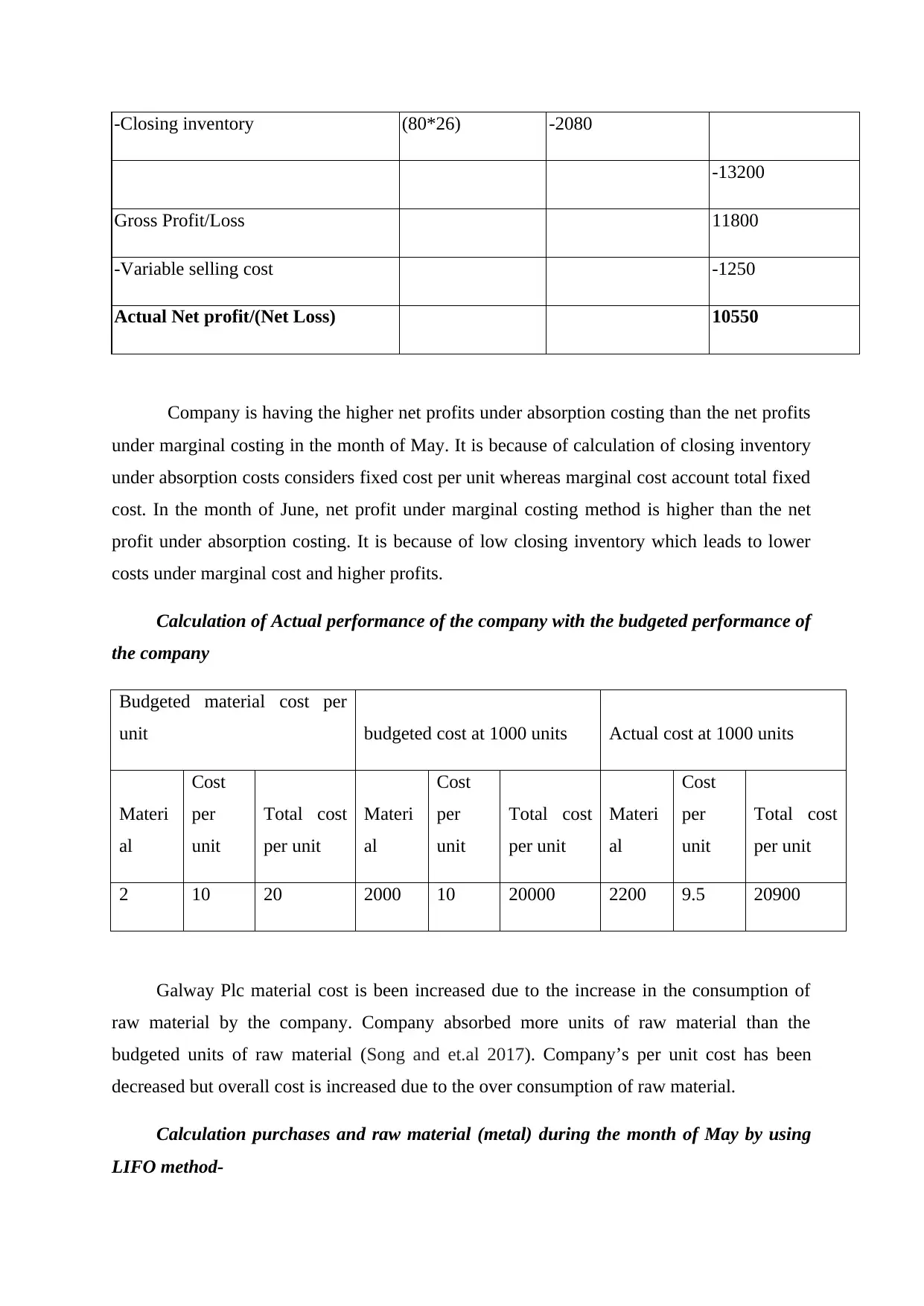
-Closing inventory (80*26) -2080
-13200
Gross Profit/Loss 11800
-Variable selling cost -1250
Actual Net profit/(Net Loss) 10550
Company is having the higher net profits under absorption costing than the net profits
under marginal costing in the month of May. It is because of calculation of closing inventory
under absorption costs considers fixed cost per unit whereas marginal cost account total fixed
cost. In the month of June, net profit under marginal costing method is higher than the net
profit under absorption costing. It is because of low closing inventory which leads to lower
costs under marginal cost and higher profits.
Calculation of Actual performance of the company with the budgeted performance of
the company
Budgeted material cost per
unit budgeted cost at 1000 units Actual cost at 1000 units
Materi
al
Cost
per
unit
Total cost
per unit
Materi
al
Cost
per
unit
Total cost
per unit
Materi
al
Cost
per
unit
Total cost
per unit
2 10 20 2000 10 20000 2200 9.5 20900
Galway Plc material cost is been increased due to the increase in the consumption of
raw material by the company. Company absorbed more units of raw material than the
budgeted units of raw material (Song and et.al 2017). Company’s per unit cost has been
decreased but overall cost is increased due to the over consumption of raw material.
Calculation purchases and raw material (metal) during the month of May by using
LIFO method-
-13200
Gross Profit/Loss 11800
-Variable selling cost -1250
Actual Net profit/(Net Loss) 10550
Company is having the higher net profits under absorption costing than the net profits
under marginal costing in the month of May. It is because of calculation of closing inventory
under absorption costs considers fixed cost per unit whereas marginal cost account total fixed
cost. In the month of June, net profit under marginal costing method is higher than the net
profit under absorption costing. It is because of low closing inventory which leads to lower
costs under marginal cost and higher profits.
Calculation of Actual performance of the company with the budgeted performance of
the company
Budgeted material cost per
unit budgeted cost at 1000 units Actual cost at 1000 units
Materi
al
Cost
per
unit
Total cost
per unit
Materi
al
Cost
per
unit
Total cost
per unit
Materi
al
Cost
per
unit
Total cost
per unit
2 10 20 2000 10 20000 2200 9.5 20900
Galway Plc material cost is been increased due to the increase in the consumption of
raw material by the company. Company absorbed more units of raw material than the
budgeted units of raw material (Song and et.al 2017). Company’s per unit cost has been
decreased but overall cost is increased due to the over consumption of raw material.
Calculation purchases and raw material (metal) during the month of May by using
LIFO method-
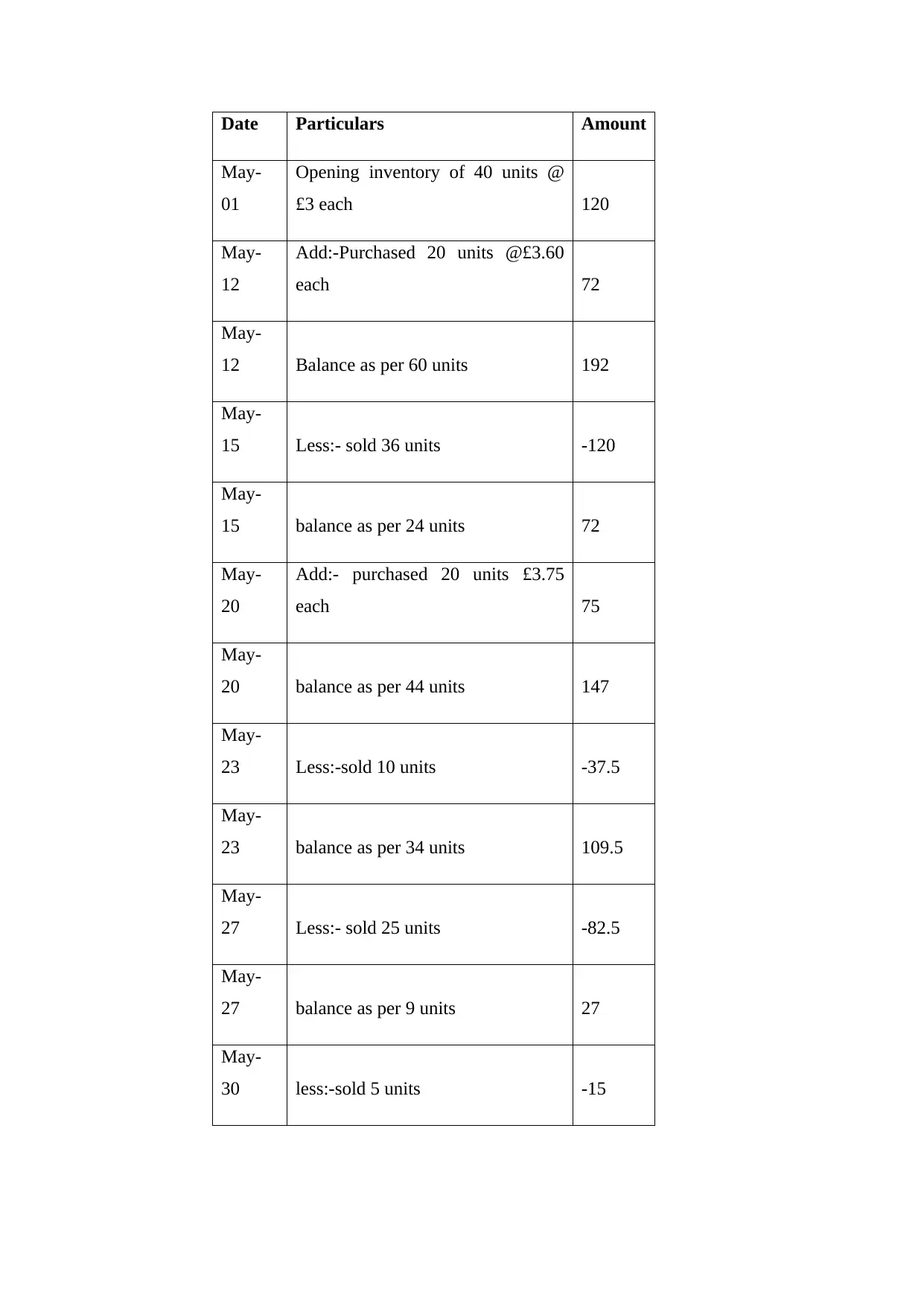
Date Particulars Amount
May-
01
Opening inventory of 40 units @
£3 each 120
May-
12
Add:-Purchased 20 units @£3.60
each 72
May-
12 Balance as per 60 units 192
May-
15 Less:- sold 36 units -120
May-
15 balance as per 24 units 72
May-
20
Add:- purchased 20 units £3.75
each 75
May-
20 balance as per 44 units 147
May-
23 Less:-sold 10 units -37.5
May-
23 balance as per 34 units 109.5
May-
27 Less:- sold 25 units -82.5
May-
27 balance as per 9 units 27
May-
30 less:-sold 5 units -15
May-
01
Opening inventory of 40 units @
£3 each 120
May-
12
Add:-Purchased 20 units @£3.60
each 72
May-
12 Balance as per 60 units 192
May-
15 Less:- sold 36 units -120
May-
15 balance as per 24 units 72
May-
20
Add:- purchased 20 units £3.75
each 75
May-
20 balance as per 44 units 147
May-
23 Less:-sold 10 units -37.5
May-
23 balance as per 34 units 109.5
May-
27 Less:- sold 25 units -82.5
May-
27 balance as per 9 units 27
May-
30 less:-sold 5 units -15
⊘ This is a preview!⊘
Do you want full access?
Subscribe today to unlock all pages.

Trusted by 1+ million students worldwide
1 out of 20
Related Documents
Your All-in-One AI-Powered Toolkit for Academic Success.
+13062052269
info@desklib.com
Available 24*7 on WhatsApp / Email
![[object Object]](/_next/static/media/star-bottom.7253800d.svg)
Unlock your academic potential
Copyright © 2020–2025 A2Z Services. All Rights Reserved. Developed and managed by ZUCOL.





